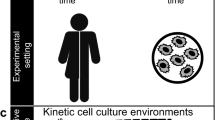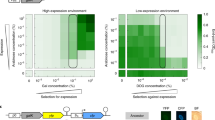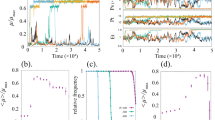Abstract
Natural selection dictates that cells constantly adapt to dynamically changing environments in a context-dependent manner. Gene-regulatory networks often mediate the cellular response to perturbation1,2,3, and an understanding of cellular adaptation will require experimental approaches aimed at subjecting cells to a dynamic environment that mimics their natural habitat4,5,6,7,8,9. Here we monitor the response of Saccharomyces cerevisiae metabolic gene regulation to periodic changes in the external carbon source by using a microfluidic platform that allows precise, dynamic control over environmental conditions. We show that the metabolic system acts as a low-pass filter that reliably responds to a slowly changing environment, while effectively ignoring fast fluctuations. The sensitive low-frequency response was significantly faster than in predictions arising from our computational modelling, and this discrepancy was resolved by the discovery that two key galactose transcripts possess half-lives that depend on the carbon source. Finally, to explore how induction characteristics affect frequency response, we compare two S. cerevisiae strains and show that they have the same frequency response despite having markedly different induction properties. This suggests that although certain characteristics of the complex networks may differ when probed in a static environment, the system has been optimized for a robust response to a dynamically changing environment.
This is a preview of subscription content, access via your institution
Access options
Subscribe to this journal
Receive 51 print issues and online access
$199.00 per year
only $3.90 per issue
Buy this article
- Purchase on Springer Link
- Instant access to full article PDF
Prices may be subject to local taxes which are calculated during checkout




Similar content being viewed by others
References
Beadle, G. W. & Tatum, E. L. Genetic control of biochemical reactions in Neurospora . Proc. Natl Acad. Sci. USA 27, 499–506 (1941)
Jacob, F. & Monod, J. Genetic regulatory mechanisms in the synthesis of proteins. J. Mol. Biol. 3, 318–356 (1961)
Douglas, H. C. & Hawthorne, D. C. Regulation of genes controlling synthesis of the galactose pathway enzymes in yeast. Genetics 54, 911–916 (1966)
Thattai, M. & Shraiman, B. I. Metabolic switching in the sugar phosphotransferase system of Escherichia coli . Biophys. J. 85, 744–754 (2003)
Lipan, O. & Wong, W. H. The use of oscillatory signals in the study of genetic networks. Proc. Natl Acad. Sci. USA 102, 7063–7068 (2005)
Kussell, E. & Leibler, S. Phenotypic diversity, population growth, and information in fluctuating environments. Science 309, 2075–2078 (2005)
Kruse, K. & Julicher, F. Oscillations in cell biology. Curr. Opin. Cell Biol. 17, 20–26 (2005)
Ronen, M. & Botstein, D. Transcriptional response of steady-state yeast cultures to transient perturbations in carbon source. Proc. Natl Acad. Sci. USA 103, 389–394 (2006)
Thattai, M. & van Oudenaarden, A. Stochastic gene expression in fluctuating environments. Genetics 167, 523–530 (2004)
Cookson, S., Ostroff, N., Pang, W. L., Volfson, D. & Hasty, J. Monitoring dynamics of single-cell gene expression over multiple cell cycles. Mol. Syst. Biol. 1 10.1038/msb4100032 (2005)
Groisman, A. et al. A microfluidic chemostat for experiments with bacterial and yeast cells. Nature Methods 2, 685–689 (2005)
Sheff, M. A. & Thorn, K. S. Optimized cassettes for fluorescent protein tagging in Saccharomyces cerevisiae . Yeast 21, 661–670 (2004)
Raser, J. M. & O’Shea, E. K. Control of stochasticity in eukaryotic gene expression. Science 304, 1811–1814 (2004)
Hasty, J., McMillen, D., Isaacs, F. & Collins, J. J. Computational studies of gene regulatory networks: in numero molecular biology. Nature Rev. Genet. 2, 268–279 (2001)
Savageau, M. A. Comparison of classical and autogenous systems of regulation in inducible operons. Nature 252, 546–549 (1974)
de Atauri, P., Orrell, D., Ramsey, S. & Bolouri, H. Evolution of ‘design’ principles in biochemical networks. Syst. Biol. 1, 28–40 (2004)
Demir, O. & Kurnaz, I. A. An integrated model of glucose and galactose metabolism regulated by the GAL genetic switch. Comput. Biol. Chem. 30, 179–192 (2006)
Kaniak, A., Xue, Z., Macool, D., Kim, J. & Johnston, M. Regulatory network connecting two glucose signal transduction pathways in Saccharomyces cerevisiae . Eukaryot. Cell 3, 221–231 (2004)
Verma, M., Bhat, O. J. & Venkatesh, K. V. Steady-state analysis of glucose repression reveals hierarchical expression of proteins under Mig1p control in Saccharomyces cerevisiae . Biochem. J. 388, 843–849 (2005)
Scheffler, I. E., de la Cruz, B. J. & Preito, S. Control of mRNA turnover as a mechanism of glucose repression in Saccharomyces cerevisiae . Biochem. Cell Biol. 30, 1175–1193 (1998)
de la Cruz, B. J., Prieto, S. & Scheffler, I. E. The role of the 5′ untranslated region (UTR) in glucose-dependent mRNA decay. Yeast 19, 887–902 (2002)
Andrade, R. P., Kötter, P., Entian, K. D. & Casal, M. Multiple transcripts regulate glucose-triggered mRNA decay of the lactate transporter JEN1 from Saccharomyces cerevisiae . Biochem. Biophys. Res. Commun. 332, 254–262 (2005)
Rohde, J. R., Trinh, J. & Sadowski, I. Multiple signals regulate GAL transcription in yeast. Mol. Cell. Biol. 20, 38803886 (2000)
Whitesides, G. M., Ostuni, E., Takayama, S., Jiang, X. Y. & Ingber, D. E. Soft lithography in biology and biochemistry. Annu. Rev. Biomed. Eng. 3, 335–373 (2001)
Whitesides, G. M. et al. Soft lithography and bioanalysis. Abstr. Pap. Am. Chem. Soc. 227, U113–U113 (2004)
Xia, Y. & Whitesides, G. M. Soft lithography. Angew. Chem. Int. Edn Engl. 37, 550–575 (1998)
Boles, E. & Hollenberg, C. P. The molecular genetics of hexose transport in yeasts. FEMS Microbiol. Rev. 21, 85–111 (1997)
Acknowledgements
We thank A. Groisman for useful discussions regarding microfluidic design; D. Volfson and C. Grilly for aid in development and testing of image segmentation and tracking algorithms, and M. Ferry for his suggestions on microbiology. This work was supported by the National Institute of General Medical Sciences of the National Institutes of Health.
Author information
Authors and Affiliations
Corresponding author
Supplementary information
Supplementary Information 1
The file contains containing specific details on methodology and computational aspects of the study, including Supplementary Figures S1-S6 and Supplementary Tables.S1-S4 (PDF 452 kb)
nature07211-s1.mov
The file contains Supplementary Movie 1. (MOV 3608 kb)
Rights and permissions
About this article
Cite this article
Bennett, M., Pang, W., Ostroff, N. et al. Metabolic gene regulation in a dynamically changing environment. Nature 454, 1119–1122 (2008). https://doi.org/10.1038/nature07211
Received:
Accepted:
Published:
Issue Date:
DOI: https://doi.org/10.1038/nature07211
This article is cited by
-
Role of Noise-Induced Cellular Variability in Saccharomyces cerevisiae During Metabolic Adaptation: Causes, Consequences and Ramifications
Journal of the Indian Institute of Science (2020)
-
Precise, automated control of conditions for high-throughput growth of yeast and bacteria with eVOLVER
Nature Biotechnology (2018)
-
Integration of genome-scale metabolic networks into whole-body PBPK models shows phenotype-specific cases of drug-induced metabolic perturbation
npj Systems Biology and Applications (2018)
-
Microfluidics Engineering: Recent Trends, Valorization, and Applications
Arabian Journal for Science and Engineering (2018)
-
Insert-based microfluidics for 3D cell culture with analysis
Analytical and Bioanalytical Chemistry (2018)
Comments
By submitting a comment you agree to abide by our Terms and Community Guidelines. If you find something abusive or that does not comply with our terms or guidelines please flag it as inappropriate.



